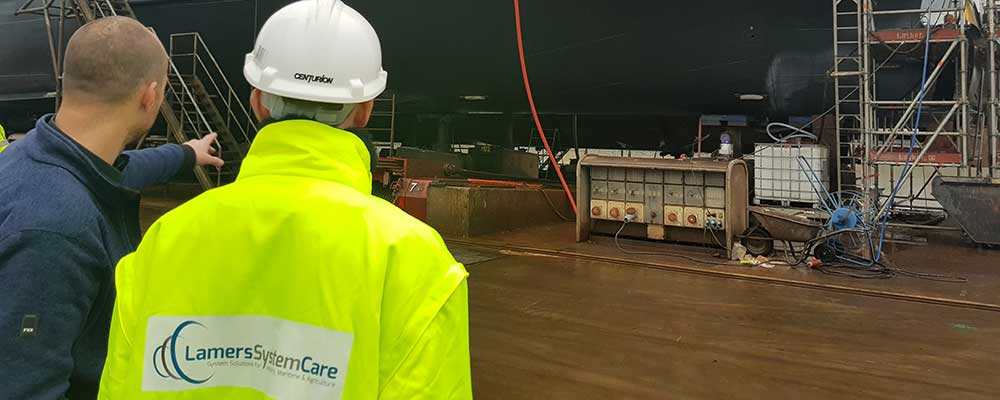Courtesy U.S. Coast Guard
Petty Officer 2nd Class Brandon O’Brien scrapes the hull of a 47-foot motor lifeboat during haul-out maintenance at Coast Guard Station Depoe Bay in Newport, Ore.
By using sound waves, ultrasonic antifouling can prevent the growth of algae, barnacles and slime on boat hulls and interiors, and can protect sea chests and box coolers as well. The technology has been employed internationally from Europe to Australia, Japan, Chile and the Caribbean, and implemented on commercial, military and recreational vessels. More recently, these systems have caught on with yacht owners in North America.
Fouled, rough hulls can slow boats and increase fuel consumption, and antifouling paints — while effective — can release toxins when a vessel is in the water or when coatings are scraped off in dry dock. Usage of ultrasound has grown following the International Maritime Organization’s ban over a decade ago on organotin in bottom paints, and because of moves to limit copper as an antifouling agent. Ultrasonic systems don’t rely on chemicals that can harm fish and mammals or pollute the air, and they can reduce vessel lift-outs for cleaning.
The cleaning abilities of sound waves have been recognized since before World War II. Starting in the 1950s, sound waves were utilized for this purpose in the food, agriculture, electronics, medical, aircraft and auto industries. While ultrasound’s marine applications have been acknowledged for decades, usage by commercial vessel operators has only gained traction in the past 15 years. To install a system, transducers are mounted inside a vessel’s hull, or on other internal features, along with a control box. Onboard generators or shore sources power the equipment.
“Wherever sea, river or estuary water touches a vessel or its internal equipment, biological organisms are at work, clogging pipework, encrusting the hull and propeller, increasing fuel consumption and requiring expensive remedial work,” said Darren Rowlands, director of NRG Marine Ltd. in the United Kingdom. “Antifouling is therefore an essential preventative measure that all commercial, military or leisure operators use to maintain smooth, fouling-free surfaces to reduce running costs and extend service intervals.”
NRG Marine, launched in 2006, manufactures Sonihull, a range of antifouling systems employing sound waves. “Using ultrasound requires less surface preparation and has less environmental impact than self-polishing and biocidal coatings,” Rowlands said. “There’s no requirement for regular replacement of parts, as with impressed-current systems. Ultrasonic antifouling can keep weeds, barnacles and mussels away without hazardous chemicals, cathodes or paints, (and) with no expensive lift-outs, scraping, high-pressure cleaning or the subsequent disposal of poisonous wastewater.”
Impressed current antifouling (ICAF) systems typically use a copper alloy rod to prevent fouling and an aluminum or ferrous alloy rod to reduce corrosion, along with a power unit.
Introduced to the market in 2008, NRG Marine’s Sonihull systems produce multiple pulses of ultrasonic energy in a range of targeted frequencies. These pulses are transmitted through the material to which the transducer is attached, whether that’s the hull, propeller shaft, pipework, box cooler or tank. The systems work on any metal or solid composite material, like glass-reinforced plastic and carbon fiber.
The pulses produce a pattern of alternating positive and negative pressure on the surface of the material, Rowlands said. Microscopic bubbles are created during the negative pressure cycle and are imploded during the positive pressure cycle.
“This microscopic surface agitation has a cleansing effect that destroys algae, the first link in the marine food chain,” Rowlands said. That keeps the surface clean and makes it a much less inviting habitat for larger organisms that feed on algae, preventing a buildup of fouling. The microscopic movement of water also prevents barnacle and mussel larvae from embedding on the surface.
“Our Sonihull systems are already in operation with several coast guards and navies around the world,” Rowlands said. “We’ve also developed technical partnerships with leading builders and propulsion manufacturers who are looking for a better way to keep weeds and barnacles off vessels. We currently have 15 distribution and installation partners around the globe, transforming how commercial, military and leisure craft are dealing with marine fouling issues.”
Ultrasonic antifouling has three big advantages, Rowlands said. “These systems are dry-installed and maintained, so there’s no need to dry dock the ship,” he said. “They are low cost compared with conventional copper-anode technology. And ultrasonic antifouling technology is green, with zero impact on the environment.”


